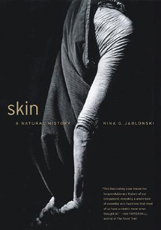Nina G. Jablonski is Professor and Head of the Department of Anthropology at the Pennsylvania State University. In this fascinating book she presents an overview of skin, our largest and most visible organ. She notes at the outset:
"Skin is key to our biology, our sensory experiences, our information gathering, and our relationships to others… It protects us from attack by physical, chemical, and microbial agents and shields us from most of the harmful rays of the sun, while it works hard to regulate our body temperature. Far from being an impervious barrier, however, the skin is a selectively permeable sheath. It is constantly at work as a watchful sentinel, letting some things in and others out. The skin is also home to hundreds of millions of microorganisms, which feed on its scales and secretions."
Human skin is unique in three aspects: it is naked and sweaty; it comes naturally in a wide range of colors; and it is a surface for decoration. According to Jablonski, more than any other part of the body, our skin showcases our individuality and forms "the centerpiece of the vocabulary of personhood." She calls this book an idiosyncratic guidebook since it covers topics of most interest to her as an anthropologist with training in comparative biology.
Jablonski begins with a look at the many services provided by the skin and then moves on to an evolutionary history of the skin, a multileveled drama that covers more than 300 million years. This is followed by chapters on sweat, skin and sun, skin's dark secret, and color. The material on touch covers a broad range of human behavior and also looks at human fingerprints. Next Jablonski examines emotions, sex, and skin. Age, environment, and disease take their toll on skin, and no one is immune to these changes. The last two chapters cover skin decoration and the future of skin in a brave new world of tomorrow.
The overall effect of reading Skin: A Natural History is to come to a fresh appreciation for our body's protective envelope and to realize how much more nurturing and creative we can be with this miraculous organ.
